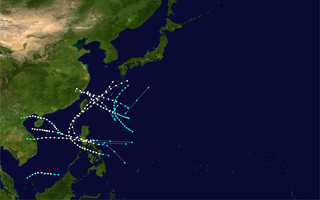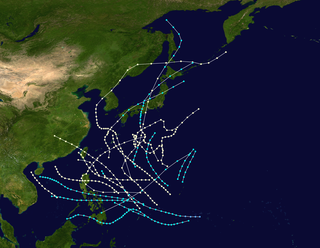The Philippines is an archipelagic country located in Southeast Asia, beside the northwest Pacific Ocean. The nation consists of 7,641 islands. The country is known to be "the most exposed country in the world to tropical storms", with about twenty tropical cyclones entering the Philippine area of responsibility each year. In the Filipino, [a] tropical cyclones are generally called bagyo.
Climatologically, in the Northwest Pacific basin, most tropical cyclones develop between May and October. However, the Philippines can experience a tropical cyclone anytime in the year, with the most storms during the months of June to September. This article includes any tropical cyclone of any intensity that affected the Philippines from 2000 onwards.

The 1959 Pacific typhoon season was regarded as one of the most devastating years for Pacific typhoons on record, with China, Japan and South Korea sustaining catastrophic losses. It was an event in the annual cycle of tropical cyclone formation. The season had no official bounds, but tropical cyclones in the Western Pacific Ocean normally develop between May and October.

The 1970 Pacific typhoon season has no official bounds; it ran year-round in 1970, but most tropical cyclones tend to form in the northwestern Pacific Ocean between June and December. These dates conventionally delimit the period of each year when most tropical cyclones form in the northwestern Pacific Ocean.

The 1966 Pacific typhoon season was an active season, with many tropical cyclones having severe impacts in China, Japan, and the Philippines. Overall, there were 49 tropical depressions declared officially or unofficially, of which 30 officially became named storms; of those, 20 reached typhoon status, while 3 further became super typhoons by having winds of at least 240 km/h (150 mph). Throughout the year, storms were responsible for at least 997 fatalities and $377.6 million in damage; however, a complete record of their effects is unavailable.

The 1964 Pacific typhoon season was the most active tropical cyclone season recorded globally, with a total of 39 tropical storms forming. It had no official bounds; it ran year-round in 1964, but most tropical cyclones tend to form in the northwestern Pacific Ocean between June and December. These dates conventionally delimit the period of each year when most tropical cyclones form in the northwestern Pacific Ocean.

The 1963 Pacific typhoon season has no official bounds; it ran year-round in 1963, but most tropical cyclones tend to form in the northwestern Pacific Ocean between June and December. These dates conventionally delimit the period of each year when most tropical cyclones form in the northwestern Pacific Ocean.
The 1939 Pacific typhoon season has no official bounds; it ran year-round in 1939, but most tropical cyclones tend to form in the northwestern Pacific Ocean between May and November. These dates conventionally delimit the period of each year when most tropical cyclones form in the northwestern Pacific Ocean.

The 1992–93 South-West Indian Ocean cyclone season lasted longer than normal, with the first storm Aviona forming on September 27 and the final storm Konita not dissipating until May 7. It was an above-average season, with four tropical cyclones – the equivalent of a minimal hurricane – along with six tropical storms, one subtropical depression, and several depressions including one that was named. The basin is defined as the area west of 90°E and south of the Equator in the Indian Ocean, which includes the waters around Madagascar westward to the east coast of Africa. Tropical cyclones in this basin are monitored by the Regional Specialised Meteorological Centre in Réunion (MFR), as well as by the Joint Typhoon Warning Center (JTWC).
The 1940 Pacific typhoon season marked an interruption in meteorological records in both the Philippines and Hong Kong due to the start of World War II. There were 43 reported tropical cyclones, including 27 that attained typhoon status. The first storm was observed in February, and the first typhoon formed two months later, killing three people along Mindanao. Several storms formed in June and July, including reports of a typhoon in the newspapers that killed 52 in South Korea, and another typhoon reported in newspapers that killed one person on Samar after dropping heavy rainfall. The strongest typhoon of the season originated in July and attained a minimum pressure of 927 mbar (27.4 inHg), as reported by a ship northeast of the Philippines.

In 1900, 23 tropical cyclones were observed in the western Pacific Ocean, north of the equator and west of the International Date Line. In that region of the world, cyclones that attain maximum sustained winds of at least 118 km/h (73 mph) are known as typhoons. Of the 23 storms, 13 were tracked by the Hong Kong Observatory. Activity occurred from January to December, although the majority of the storms formed from June to November.

In 1901, 21 tropical cyclones were observed in the western Pacific Ocean, north of the equator. In that region of the world, cyclones that attain maximum sustained winds of at least 118 km/h (73 mph) are known as typhoons. Out of the 21 storms, the Hong Kong Observatory tracked nine of them. The strongest storm, known as the De Witte typhoon, reached a minimum barometric pressure of 920 mbar (27 inHg), before striking eastern China.
In 1927, there were 27 tropical cyclones observed in the western Pacific Ocean, north of the equator and west of the 180th meridian. Many of these storms affected the Philippines, China, and Japan, collectively leaving 15,952 fatalities. The strongest storm of the year also had the lowest barometric pressure recorded in a tropical cyclone worldwide at the time. On August 18, the Dutch steamship Sapoeroea recorded a barometric pressure of 886.7 millibar about 740 kilometres (460 miles) east of Luzon. This typhoon later struck near Hong Kong, where it halted transportation, wrecked buildings, and killed 15 people.
The 1942 Pacific typhoon season has no official bounds; it ran year-round in 1942, but most tropical cyclones tend to form in the northwestern Pacific Ocean between June and December. These dates conventionally delimit the period of each year when most tropical cyclones form in the northwestern Pacific Ocean. The scope of this article is limited to the Pacific Ocean, north of the equator and west of the International Date Line. Storms that form east of the date line and north of the equator are called hurricanes; see 1942 Pacific hurricane season.
The 1943 Pacific typhoon season has no official bounds; it ran year-round in 1943, but most tropical cyclones tend to form in the northwestern Pacific Ocean between June and December. These dates conventionally delimit the period of each year when most tropical cyclones form in the northwestern Pacific Ocean. The scope of this article is limited to the Pacific Ocean, north of the equator and west of the International Date Line. Storms that form east of the date line and north of the equator are called hurricanes; see 1943 Pacific hurricane season.

The 1944 Pacific typhoon season has no official bounds; it ran year-round in 1944, but most tropical cyclones tend to form in the northwestern Pacific Ocean between June and December. These dates conventionally delimit the period of each year when most tropical cyclones form in the northwestern Pacific Ocean. The scope of this article is limited to the Pacific Ocean, north of the equator and west of the International Date Line. Storms that form east of the date line and north of the equator are called hurricanes; see 1944 Pacific hurricane season.
There were 30 tropical cyclones in the western Pacific Ocean in 1931, including 19 typhoons, as well as one that developed in December of the previous year. The most significant typhoon was one that struck eastern China near Shanghai in the midst of the country's worst floods on record; heavy rainfall caused levees to collapse along the Grand Canal, killing an estimated 300,000 people, including about 2,000 people overnight in the city of Gaoyou.
The following is a list of Pacific typhoon seasons from 1920 to 1935. Data from these years was extremely unreliable, so there were many more typhoons that did not hit land and were not detected by ships. The average from these times was 23 tropical storms, which now would be considered a well-below-average season.
This article encompasses the 1890s Pacific typhoon seasons.

In 1936, there were 33 tropical cyclones across the northwestern Pacific Ocean, north of the equator and west of the International Date Line, including two that persisted from the previous year. There were at least 19 typhoons, which are tropical cyclones with sustained winds of at least 119 kilometres per hour (74 mph). The year's strongest observed typhoon was in August, when the Fathomer rode out the storm in along the northern Philippines island of Luzon, observing a barometric pressure of 913 mbar (26.96 inHg). The typhoon killed 20 people, one of several deadly tropical cyclones in the year. Also in August, a typhoon crossed the Korean peninsula, killing 1,516 people, with another 1,183 people injured. In October, another typhoon moved across Luzon, killing 546 people.
In 1937, there were 25 tropical cyclones across the northwestern Pacific Ocean, north of the equator and west of the International Date Line. There were at least 17 typhoons, which are tropical cyclones with sustained winds of at least 119 kilometres per hour. The year's strongest observed typhoon was in November, when a barometer in the eastern Philippines observed a barometric pressure of 951 mbar (28.1 inHg). The typhoon was the second in a series of three to make landfall in the eastern Philippines between November and December, resulting in a collective 289 fatalities, as well as causing an outbreak of dysentery. However, the deadliest storm of the season was a typhoon that struck Hong Kong in September, killing at least 11,000 people, mainly fishermen.

In 1902, there were 24 tropical cyclones across the northwestern Pacific Ocean, north of the equator and west of the International Date Line. There were at least 11 typhoons, which are tropical cyclones with sustained winds of at least 119 kilometres per hour. The most effective storm of the year was an unnamed storm that spawned on October 1. The storm caused 600 fatalities and damages to Japan. Another unnamed storm, which formed on July 16, killed 20 people in Hong Kong.